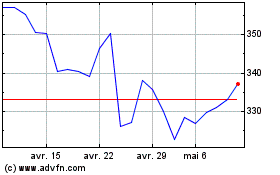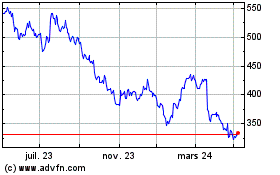By Matthew Dalton
The mass production of cashmere, once solely a luxury good, is
fueling ecological destruction that has fashion labels searching
for new sources of the fiber -- or giving it up altogether.
Herds of cashmere goats, whose hair is used to produce the soft
fabric, have grown sharply since the turn of the century in China
and Mongolia, which supply 90% of the world's cashmere.
The once-scarce fiber has become cheap enough for mass-market
labels, resulting in billions of dollars in sales, but with
ecological consequences. Millions of goats are chewing through the
vast grasslands, known as steppe, that straddle the
Mongolian-Chinese border. Nearly 60% of Mongolian pasture land is
degraded, the Mongolian government says, including large swathes
that have turned into desert.
Those problems are pushing fashion labels to respond.
Fast-fashion giant Hennes & Mauritz AB in March said it would
phase cashmere out of its product lineup by 2020. Gucci parent
Kering SA is backing a project to encourage Mongolian herders to
graze their goats in ways that protect the steppe. Stella McCartney
and Patagonia have sworn off cashmere produced directly from goats
in favor of garments made using cashmere scraps left over from
workshops.
"We hope that it will be possible to source cashmere more
sustainably in the future, and we want to contribute to making the
industry more transparent and responsible," H&M said.
As cashmere production has surged, its environmental footprint
is attracting scrutiny from governments and environmental groups.
The industry has been more sensitive to charges that supply chains
harm the environment or encourage animal cruelty -- and more active
in addressing problems. These moves are seen as attractive to
younger shoppers who are more attuned to the issue.
H&M decided to stop using cashmere after People for the
Ethical Treatment of Animals, or PETA, told the company about an
undercover investigation it conducted at slaughterhouses and
facilities in Mongolia and China where hair is removed from the
goats. The investigation alleged the goats were treated cruelly
when their hair was collected and when they were killed for their
meat.
"PETA has made us aware that there are animal-welfare issues in
the production of cashmere," H&M said, "and we agree with them
that they need to be addressed." In a video taken during PETA's
investigation, braying cashmere goats are held down while metal
combs are raked over their hair.
The complexity of the cashmere supply chain has made it
difficult for brands to determine whether the cashmere they buy is
coming from herders who adhere to environmental and animal-welfare
standards. Plus, brands have limited visibility on supply chains
that go through Inner Mongolia, which is part of China, because of
restrictions on foreign companies doing business in the
country.
Once hair is removed from the goats, it passes through many
middlemen. From Mongolia, it is usually shipped across the border
to processing facilities in China, where the fibers are often mixed
with those from goats raised in China, the world's largest producer
of cashmere. Then the fabric is either made into garments in China
or shipped to Europe, where high-end brands such as Gucci and
others use it.
Bigger goat herds have led to surging exports of cashmere fiber
to Europe, and surging exports of finished cashmere garments --
such as sweaters, scarves and suits -- mainly from Italy, to the
rest of the world. Italian cashmere garment exports rose to EUR305
million ($342.5 million) in 2018, from EUR171 million in 2008,
representing about 4% of total Italian garment exports.
High-end brands in recent years have been working to establish a
presence in Mongolia and China, encouraging herders to graze their
animals in ecologically friendly ways.
"Unfortunately, the approaches are very strong on paper and very
weak in fact," said Giovanni Schneider, chief executive of
Schneider Group, which trades cashmere out of Mongolia.
Mr. Schneider, who is working with Kering, said the challenge is
getting herders scattered across Mongolia's vast steppe to follow
guidelines.
"It's very difficult to engage the herder and explain that
growing sustainable cashmere is a good thing to do," he said. While
herders have been receptive, "it's very hard to go against the
tradition of nomadic life," he added.
Kering has been looking to buy cashmere in Mongolia from herders
who follow good land-management practices. These include rotating
goats off heavily grazed areas to allow grassland to renew itself.
The company has been working with the Wildlife Conservation
Society, NASA and Stanford University on its project.
Despite such programs, grassland destruction has advanced in
recent years. Mongolian authorities say 23% of the nation's grazing
land as of 2016 was either heavily or fully degraded, up from 13%
in 2014. The number of grazing sites that will require at least 10
years to be replenished -- or may be irrecoverable -- rose by 5%
from 2014 to 2016, the authorities said.
Ultimately, the authorities in both Mongolia and China need to
convince herders to reduce the size of their herds, says Gabriella
Spirli, a development official at the Swiss embassy in Mongolia,
which has been working with the government to fight
overgrazing.
"Instead of quantity improve the quality," Ms. Spirli said. "You
don't need to have so many animals like you have now."
Write to Matthew Dalton at Matthew.Dalton@wsj.com
(END) Dow Jones Newswires
May 13, 2019 08:20 ET (12:20 GMT)
Copyright (c) 2019 Dow Jones & Company, Inc.
Kering (EU:KER)
Graphique Historique de l'Action
De Mar 2024 à Avr 2024

Kering (EU:KER)
Graphique Historique de l'Action
De Avr 2023 à Avr 2024
